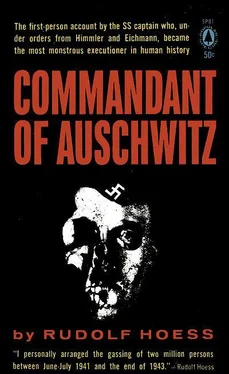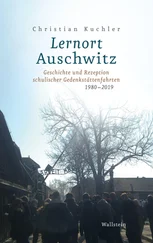Budy was a village some five miles from the Auschwitz base camp, where a punishment company of prisoners was stationed and employed on drainage work connected with the Vistula. This punishment unit was completely cut off from the rest of the camp and the Capos of both sexes, who were recruited from among the criminals, conducted a reign of terror over their prisoners.
The female equivalent of the SS guards.
One of the agricultural undertakings run from Auschwitz. There was also a fish-processing plant at Harmense.
The Raisko estate belonged to Auschwitz and was farmed to the SS. It had a plant-breeding establishment run by Dr. Caesar, who in February 1942 was made responsible for all the agricultural work carried out by the Auschwitz prisoners.
See Appendix 5.
Aktion Reinhardt was the code name given to the operation of collection and marketing the clothing, valuables, and other belongings, including gold fillings from teeth, and women’s hair, taken from the slaughtered Jews.
Dog squad.
The commander of the SS guard regiment at Auschwitz from 1942 on was Friedrich Hartjenstein.
See Appendix 7.
The reference is doubtless to Hitler’s notorious instructions, dated March 30, 1941, and June 6, 1941, “On the Treatment of Political Commissars.”
A crystalline powder.
See Appendix 3.
The Einsatzkommandos which moved into Russia behind the advancing German armies and massacred the Russian Jews. See Poliakov and Reitlinger, op.-cit.
See Appendix 7.
Hans Höfle was Globocnik’s chief of staff at Lublin. He was later transferred to Oranienburg, where he and Hoess became friends.
One of the first, if not the very first, of these was a transport of Jews from Beuthen on February 15, 1942.
See Appendix 1.
This, the Sonderkommando, consisted of prisoners.
It may be mentioned in this connection that in the summer of 1944 a determined, armed attempt to break out of Birkenau was made by the Jewish Special Detachment with the help of other prisoners from the women’s camp, the stores camp called “Canada,” etc. It proved abortive, however. Four hundred and fifty-five prisoners and four SS noncommissioned officers were killed during this armed uprising.
Head of the Gestapo office for the Kattowitz district, in which Auschwitz was located.
The river Sola, which flows into the Vistula a few miles north of Auschwitz, formed the eastern boundary of the Auschwitz camp area.
Hoess’s predecessor as head of Department DI in the Economic Administration Head Office was Arthur Liebehenschel. He became commandant of Auschwitz I. He proved, incidentally, a considerably less cruel and brutal commandant than Hoess had been.
See Appendix 6.
See Appendices 2 to 9.
Heinrich Müller, the head of the Gestapo. See Appendix 4
Hoess is, inexplicably enough, confused about the organization in which he worked. According to an organization plan of the Reich Security Head Office dated October 1, 1943, there was no Subsection (Referat) IVb. There was a Department ( Aintsgruppe) VIb of the Reich Security Head Office, which had four subsections, the first three of which dealt with Catholicism, Protestantism, the sects and Freemasonry, while the fourth (Eichmann) was responsible for Jewish matters. A special administrative subsection for protective custody matters formed part of Department IVc, under Dr. Berndorff, and was referred to as Subsection IVc2.
Joseph Kramer, a member of the SS-Totenkopf organization, had been employed in concentration camp duties since 1934. In 1940 he was, for five months, Hocss’s adjutant at Auschwitz. Transferred to Natzweiler, he returned in May 1944 to Auschwitz, where he succeeded Hartjenstein, who then became commandant of Natzweiler, as commandant of Auschwitz II or Auschwitz-Birkenau. In December 1944 he was made commandant of Bergen-Belsen, where he remained until the end.
Bergen-Belsen was created in the spring of 1943 as a concentration camp for privileged Jews, by which was meant the so-called “exchange” Jews, persons with British or American nationality or with papers of a neutral power, as well as Jews who were believed to have some sort of bargaining value. Until late in 1944 the number of jews in Bergen-Belsen did not exceed 15,000 and at that time conditions in the camp were relatively good, certainly far better than in the other camps. But in the winter of 1944-45 Bergen-Belsen was made into a reception camp for sick prisoners. During the evacuation of the camps located in the East and West, Auschwitz, Sachsenhausen, Natzweiler, etc., a steady stream of prisoners, most of whom were sick, began to pour into Bergen-Belsen, until its population reached some 50,000, living in the most appalling conditions and with a daily death roll of 250 or 300. The camp was liberated by the British on April 15, 1945.
The visit in question took place in March 1945. “Mittelbau” was the name given, in the summer of 1943, to the complex of work camps, underground factories, etc., controlled by the Mittelwerke Company and located in the Harz mountains, principally near Salza. The major part of the work was the production of V-weapons, and very large numbers of prisoners were employed in this, being drawn in the main from Buchenwald concentration camp. This complex of camps was also known as Dora, and the Jiving and working conditions that prevailed there, even as early as 1943, were catastrophic. On October 28, 1944, the majority of the prisoners engaged in work in this area were concentrated into one camp, which was called Dora, and which then contained some 24,000 persons, while a further 8,000 prisoners who continued to live in work camps were now controlled from Dora. By the spring of 1945 Dora, or Mittelbau, contained some 50,000 prisoners, despite an exceptionally high mortality rate. When in April of 1945 American troops approached the southern Harz mountains, Himmler ordered that all the inmates of Dora be gassed in the subterranean installations. A series of accidents prevented the implementation of this order, and finally in mid-April the inmates were evacuated to Bergen-Belsen.
The Federal German Statistical Office has estimated (1956) the total number of civilian dead in all Germany throughout the war, killed by air action, at 410,000.
See Appendices 8 and 9.
Gross-Rosen, near Schweidnitz in Lower Silesia, had been a concentration camp since May 1941. In 1944 it contained some 12,000 inmates. Gross-Rosen with its numerous subsidiary camps scattered throughout Lower Silesia, East Saxony, and the Sudetenland was to receive the inmates from Auschwitz according to the evacuation plan. However, as early as March 21, 1945, Gross-Rosen had itself to be evacuated, and was moved to Reichenau in Bohemia, where the camp was finally liberated on April 5, 1945.
Читать дальше












